|
|
Hola Viajero! 
Aug 25, 2006 06:00 PM Kolkata and Madre Teresa
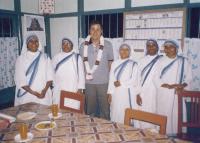 I arrived to Kolkata Howrah station, crossed the famous bridge and walked until the backpacker Sudder Street, with hundreds of cheap hotels where for just 1 euro you can find a bed in a dormitory. I saw many Spaniards, and in many restaurants some waiters spoke pretty good Spanish language. It was due to the hordes of volunteers from every corner of Spain, Sevilla, Madrid, Barcelona, Hospitalet, etc., that nobly sacrificed their summer holidays to work, for free, in Mother House, near Sudder street, with the sisters of Madre Teresa, helping handicapped children or dieing people to leave this world with love. They were virtuous travellers and soon I made friends with them in Jo-Jo restaurant or in the hotel Maria, where I rented a single room for 200 rupees.
I arrived to Kolkata Howrah station, crossed the famous bridge and walked until the backpacker Sudder Street, with hundreds of cheap hotels where for just 1 euro you can find a bed in a dormitory. I saw many Spaniards, and in many restaurants some waiters spoke pretty good Spanish language. It was due to the hordes of volunteers from every corner of Spain, Sevilla, Madrid, Barcelona, Hospitalet, etc., that nobly sacrificed their summer holidays to work, for free, in Mother House, near Sudder street, with the sisters of Madre Teresa, helping handicapped children or dieing people to leave this world with love. They were virtuous travellers and soon I made friends with them in Jo-Jo restaurant or in the hotel Maria, where I rented a single room for 200 rupees.
I visited Mother Teresa House where I saw her tomb revered in one of the rooms of the ground floor. Some sisters told me that they have just saved that day the life of a little girl. Her father wanted to cut her throat with a machete for having been born female. One of the sisters arrived in time to convince the father not to do so, and took his daughter to Mother Teresa House. I was welcomed and we celebrated together the new life of the little girl.
My last day in Kolkata I bought for my daughters beautiful silk embroideries, eye-catching jewellery items and delicate perfumes, distributed my remaining rupees among the most desperate beggars of Sudder street and headed to the airport.
Now I am ready to fly back to Barcelona, in my dear Spain, to work and save money to organize my next journey to Siberia overland, via the Military Georgian Pass until Chechnya and Dagestan, as every year use to do with the aim to spend Catholic and Orthodox Christmas together with my younger daughter.
Happy New Year 2007 to everybody!
|
Aug 21, 2006 06:00 PM Tawang Monastery
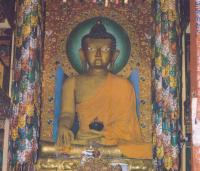 The monastery belongs to the Gelugpa and was even more stunning that the Potala of Lhasa. There lived about 500 monks, and also some workers in the houses in the middle of the monastery. It was founded in the XVII century by the 5th Dalai Lama, and precisely there was born the 6th Dalai Lama.
The monastery belongs to the Gelugpa and was even more stunning that the Potala of Lhasa. There lived about 500 monks, and also some workers in the houses in the middle of the monastery. It was founded in the XVII century by the 5th Dalai Lama, and precisely there was born the 6th Dalai Lama.
The 14th Dalai Lama will visit Tawang Monastery again in 2007 during the Padmashambhava dances in the full moon of May.
The views from that monastery were superb! Tawang is the second largest monastery in Asia, only behind of Potala, in Tibet.
When I was about to leave for Kolkata, one of the monks, Lama Champa, decided to accompany me because he feared that in the way back to Assam I would not have the unbelievable luck with the Indian soldiers that I had when entering Arunachal Pradesh. If asked, he would reply that I was a guest of the Tawang monastery.
Lama Champa travels every year to Europe, where remains for a few months teaching Buddhist meditation techniques in Buddhist centres in Warsaw, Berlin and Murcia, in Spain.
One morning at 5 AM we embarked in a minibus and at about 6 PM we reached Tezpur, back in Assam, from where we both travelled in a night bus to Guwahati. Then we separated. Lama Champa took a train to Delhi to organize his new trip to Europe. I travelled by night train straight to Kolkata.
|
Aug 20, 2006 06:00 PM Between Tibet and Bhutan
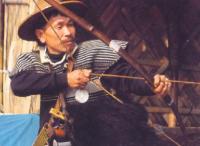 At 5 AM I was ready to board the first minibus passing through Tippi with direction to Tawang. There were some other passengers with me. Soon a minibus stopped.
At 5 AM I was ready to board the first minibus passing through Tippi with direction to Tawang. There were some other passengers with me. Soon a minibus stopped.
First the driver filled the interior of the minibus with great quantities of women, even on every leg of the driver there was a woman sited. I was installed in the last row. He asked me if I have the Inner Permit and I nodded my head affirmatively.
I did not mind to be caught by the Indian Army and sent to jail. I have been in half a dozen of them for crossing to forbidden places, and use them as meditation monasteries where I clean improper thoughts. I heard that in Indian jails are very humane and they feed the prisoners with tali gujarati, dhal, chapatti, chai, and lassi on Sundays. In Bahamas prison I was allowed to play golf, but in Asuncion, Paraguay, the first two weeks I was only given water, and nothing of food. I could write a guide for Lonely Planet titled “Across the jails of the five continents on the cheap”.
There are hundreds of thousands of Indian soldiers everywhere around Arunachal Pradesh. In 1962 the Chinese invaded that state and there was a fiery fight. Arriving to Bomdila a soldier looked inside the minibus where I was. I made as if sleeping. He touched my shoulder and asked me something in Hindi that I did not understand. With cold blood I replied: “Acha” and he went away!
Acha is a very useful Hindi word, it can mean yes, OK, I understand, oh I see, but also: yes but please leave me in peace.
After crossing some villages where the natives practiced archery, I arrived about 6 PM to Tawang and at once headed to the Buddhist monastery on the top of a hill dominating the town. I was accepted immediately by the monks to live there. Everybody was interested for the Rumtek Gompa news that I brought.
|
Aug 19, 2006 06:00 PM Arunachal Pradesh, my seventh Sister
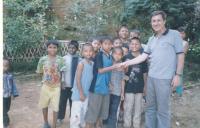 During the bus journey from Tezpur I made friendship with a native of Arunachal, a Monpa, ethno that is like the Tibetans, including the language. I expressed him my intention to enter Arunachal Pradesh. When we arrived at Bhalukpong, the border with Arunachal, I said to him:
During the bus journey from Tezpur I made friendship with a native of Arunachal, a Monpa, ethno that is like the Tibetans, including the language. I expressed him my intention to enter Arunachal Pradesh. When we arrived at Bhalukpong, the border with Arunachal, I said to him:
“Indians are jealous of you. You have so many beautiful places in Arunachal Pradesh that if they allowed the foreigners to visit them then many, instead of travelling to Jaipur, Taj Mahal or to the Kerala Backwaters, would come here”.
Then my Monpa friend replied me:
“You are right; I will help you to visit my state. Indians are not good”.
We crossed together the border line, to the Bhalukpong arunachali, because it was a divided city, like Nicosia. The Indian soldier looked at us but since my friend was covering me, they only saw a black hair man accompanying a local Monpa and did not stop me.
Finally I had entered my seventh Sister!
In Bhalukpong arunachali, without delay, I entered a cafeteria to order chai meanwhile my friend arranged a fair price with the driver of a minibus (only 80 rupees) to transport me to Tippi, a quiet Arunachal village at 6 kilometres distance well inside Arunachal Pradesh territory, where he knew of a hotel where nobody will ask me questions or to see my passport to sleep.
In the hotels of the forbidden states, if you are a foreigner, or even Indian, you need to fill a supplementary form indicating the number of your Restricted Area Permit or the Inner Permit which is delivered to the Police every night.
|
Aug 17, 2006 06:00 PM Nagaland and Naga people
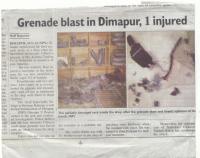 There are 5 millions Nagas, two in Nagaland, one in Manipur, one in Arunachal Pradesh, and one in Myanmar.
There are 5 millions Nagas, two in Nagaland, one in Manipur, one in Arunachal Pradesh, and one in Myanmar.
Nagas, immediately after the British withdrawal from India, declared their independence on 14th August 1947, the only tribe in the North East territories to do so. India declared its independence one day later, on 15th august.
I saw in a map that the train would penetrate a small fragment of Nagaland, the commercial town of Dimapur. But I was told by the passengers that in the station I will be required the Restricted Area Permit and that those days after Independence Day all the train stations were filled up with soldiers looking for weapons because recently the terrorist have blasted a grenada in Dimapur.
I would have to jump off the train while in motion. Have you ever tried? It is not like in the films, I can assure you, but much harder. I tried only once, in Boise, Idaho, in my time of hobo in the USA and almost broke my two legs.
I was lucky, just before reaching Dimapur the train slowed down and thus I could jump easily, it was like a children game, and this time did not fall to the floor as in Boise. I surrounded the station and when to the bus station.
“Go openly”, I remembered.
I boarded a minibus and left to Kohima, Nagaland capital. After a few kilometres there was a control besides a pretty gate with fantastic animals carved in it. One soldier looked inside and not noticing anything strange gave orders to open the barrier to let us continue to Kohima. Hurrah!
Afterwards I was told that for my aspect, with black hair and brown eyes, I looked like a kachemiri from Srinagar, and being the naga so decent people, they figured out that if I travelled to Kohima was because I had the permit with me. They are so honest that cannot imagine a foreigner entering their state without the authorization.
I visited the cemetery, the main tourist attraction of Kohima, which was in the same centre of the town.
Kohima is surnamed the Asiatic Stalingrad. The battle fought there during WWII was horrible and many thousands of lives, Japanese, British and Indians, were lost.
After that visit I continued by taxi through the same road up to the hill where was located the imposing Catholic Cathedral.
I felt like naked in Kohima. Not a single foreigner in sight, or an Indian. And Naga people are rather small. I felt that everybody was staring at me with unusual interest asking themselves who was I and why I was in their land.
The priests in the Catholic Cathedral were so disconcerted by my embarrassing visit that they asked me what I preferred, to be reported to the police or to be helped to get back to Dimapur where they knew of a hotel where foreigners are not asked the Restricted Area Permit.
I opted for the second variant and arrived to a hotel in Dimapur at night. Next day I took a bus to Tezpur, back in Assam, then another one to Bhalukpong, on the border with Arunachal Pradesh, my seventh Sister.
|
Aug 16, 2006 06:00 PM Manipur, the belicose Sister
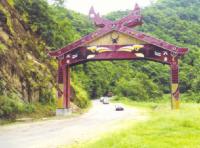 I reached Silchar and instantly took a bus to the border with Manipur, my fifth Sister.
I reached Silchar and instantly took a bus to the border with Manipur, my fifth Sister.
I selected the company of the passengers in the minibuses and chose one with only Indian businessmen heading to Imphal. The border was OK; nobody noticed that I was a foreigner.
Manipur is special because the Indians do not need Inner Permit, only foreigners, so I rightly presumed that the controls at the borders would be less severe.
At the border the agents were looking for weapons, not for “enfants terribles”.
All the way was filled with Indian soldiers, hundreds, thousands of them took positions up the hills, up the trees and in every crossroad. Anyway, I felt secure thanks to the advice of my monks’ friends “Go openly” that I recited to myself as a mantra.
We crossed Jirigat and Jiribam. We wanted to reach Nungba to make a break for lunch, but before that an Indian officer stopped our car and asked the driver: What is the purpose of you journey?
We then were told that there was curfew in Imphal, the capital of Manipur. During Indian Independence Day, the 15th of August, the terrorists had thrown a bomb into a Hindu temple and as consequence of that two Indians died. In Nagaland too there have been terrorist incidents during those days.
Then the agent realized that I was a foreigner, but only greeted me in english language and did not request me any document, nor the passport or the Restricted Area Permit.
We all were “invited” to go back to Silchar. On the way we stopped in Jiribam for lunch and then crossed the border and continued until Silchar, back in Assam, from where I took a night train to my sixth Sister: Nagaland.
|
Aug 14, 2006 06:00 PM Aizawl the beautiful
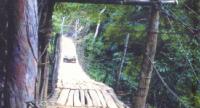 I was told about a British traveller who entered Mizoram illegally twice and twice was put in jail. Local people helped me a lot. Indeed I had been fortunate.
I was told about a British traveller who entered Mizoram illegally twice and twice was put in jail. Local people helped me a lot. Indeed I had been fortunate.
The minibus took the whole day to reach Aizwal through endless bamboo jungles and hanging bridges. Most of Mizoram is mountainous.
Aizawl is a lovely town living in vertical; there are no rickshaws because of the hills, but taxis charge 50 rupees for ride. People lived in a sort of palafitos, with half of the house built in the hill land plus the rest protracted with long wooden pillars. During the night the many hills of Aizawl looked as illuminated Christmas trees.
I was accepted to spend the night in the Catholic Cathedral, in the Bishop House.
What I heard about the customs and history of the peaceful Mizo people caused me admiration.
Next day, during the exit to Assam, I saw a training camp for guerrillas in the jungle where there were Israelis and Cubans.
Nobody checked me. I travelled openly.
|
Aug 11, 2006 06:00 PM Mizoram, the lost Shangri-La
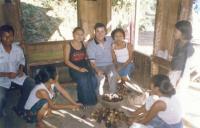 While crossing the bridge I heard two girls taking and looking at me. I only understood the word “foreigner”. I followed my way faster and, Dios mio, que emocion! There were no soldiers at the other side of the bridge; I had entered in Mizoram, and openly, as my monks’ friends suggested me!
While crossing the bridge I heard two girls taking and looking at me. I only understood the word “foreigner”. I followed my way faster and, Dios mio, que emocion! There were no soldiers at the other side of the bridge; I had entered in Mizoram, and openly, as my monks’ friends suggested me!
I slept in the patio of a school and next day, at 4.30 AM, I asked a driver of a minibus going somewhere in the direction to Aizwal to take me with him. When we arrived at his village he invited me to be his guest. I cheerfully accepted and spent two days with his family, who had a shop selling beetle nuts.
After two days with that family I almost got married to the elder daughter, charming Mapuii, but I said to myself: “No, I am a traveller and must keep on travelling learning from my world, I do not have time for love”, and thus next day I proceeded to Aizawl, the capital of Mizoram.
Adios bella Mapuii. Tal vez un dia volvere.
|
Aug 09, 2006 06:00 PM Matabari Temple, Tripura
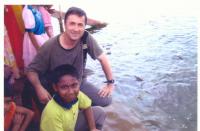 The way from Shillomg to Agartala took me twenty hours in the back of a bus. All the time I saw soldiers everywhere. They took positions in every hill, up in the trees; it looked like in a war film. Many of them were Sikhs. They were protecting us from terrorists and bandits and all the buses travelled in convoys protected by the Indian Army as escorts. Land rovers with Indian soldiers with their weapons ready to shoot were situated at the beginning and at the end of every convoy.
The way from Shillomg to Agartala took me twenty hours in the back of a bus. All the time I saw soldiers everywhere. They took positions in every hill, up in the trees; it looked like in a war film. Many of them were Sikhs. They were protecting us from terrorists and bandits and all the buses travelled in convoys protected by the Indian Army as escorts. Land rovers with Indian soldiers with their weapons ready to shoot were situated at the beginning and at the end of every convoy.
In Tripura people speak Bengali and you can observe several Kali temples (main Bengali Goddess) in the towns.
I visited a palace in the middle of a lake, called Neermahal, which reminded me the palaces in Rajasthan, and then went to Udaipur (not to be confused with the other Udaipur town in Rajasthan) where I would spend a whole day admiring its many wonders.
The main tourist attraction in Udaipur is one of the 51 “pithas” or holiest pilgrimage centres on India: Tripura Sundari Temple, also known as Matabari. It consists of a square type sanctum of a typical hut construction. I took my shoes off and walked inside during the time of the sacrifices, where for 10 rupees a man with a sword cut the throats of young goats to be offered to the Hindu gods. They also cut buffalos heads for 25 rupees. The blood even reached the faithful people around.
Some metres ahead I descended to a lake where the people fed thousands of enormous tortoises with puffed rice and biscuits.
Everywhere I went I noticed that a boy of about ten years old was following me around the temple as well as his parents. The boy asked me something in Hindi, but I replied in English that I did not understand. He then asked me in English to take him with me. I was astonished, and the parents too. First I thought that I was the first foreigner that the boy has seen in his life. But no, they were from Kolkata, rich tourists, the mother had a good camera and the father a video. But the boy insisted. Finally we all agree to take some pictures of both of us together. After that the boy remained satisfied. (See the picture with the boy and the turtles).
After Tripura I tried to visit the four forbidden states of the Seven Sisters. I studied a map, talk with the local people and headed to a village at the border with Mizoram. There I studied during a whole day the soldiers’ movements and the change of guards from a cafeteria drinking chai, then, at dark, when the soldiers lessened their duty, crossed a bridge across a river and entered unnoticed to Mizoram, the fourth Sister.
Sorry, but I do not want to describe the whereabouts of that magical bridge that permitted me to traverse to Mizoram, the lost Shangri-La. Travellers might find it if they persevere, but tourists better do not try. Mizo people have intuition and will accept the real travellers as seekers of the true, but the tourists, those who travel for leisure and bargain with the poor sellers for peanuts, or take pictures indiscriminately, will be denounced to the Indian Army.
|
Aug 07, 2006 06:00 PM Cherranpunjee, Meghalaya
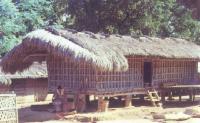 Shillong, Meghalaya capital, is a pretty town situated at about 1500 meters of altitude over the sea level. They are an interesting bazaar called Bara (Bara means great in Hindi)) and a pedestrian street in the Police Bazaar full of life during the night with stalls of food everywhere.
Shillong, Meghalaya capital, is a pretty town situated at about 1500 meters of altitude over the sea level. They are an interesting bazaar called Bara (Bara means great in Hindi)) and a pedestrian street in the Police Bazaar full of life during the night with stalls of food everywhere.
Meghalaya is inhabited by three tribal groups (Khassis, Jaintias and Bhois) that follow the matrilineal system society where the lineage and property pass down from mother to daughter and nothing is left for the sons.
In every Indian town you can find a travel agency offering one day excursions very cheap, for about 120 rupees (2 euro) showing you the main attractions of the town and surroundings. I bought such a cheap tour that lasted from 8 AM to 5 PM and admired the fourth highest water fall in the world (the first being Salto Angel in Venezuela). I also visited Don Bosco museum, Ramakrishna Mission, grottoes with stalactites symbolising the lingam of Shiva, typical houses and many other gorgeous places, such as Cherranpunjee, famous for being the heaviest rainfall area in the world. To get there we passed through gorges, exuberant vegetation, and saw lands belonging to Bangla Desh.
People were nice everywhere and saluted us with the greeting Namaste and immediately asked us “Apgesahe”.
One night I took a bus to Agartala, the capital of Tripura, the third Sister.
|
Page:
 2 3 4 5 6 7 8 9 10 11 12
2 3 4 5 6 7 8 9 10 11 12

|
|
|
